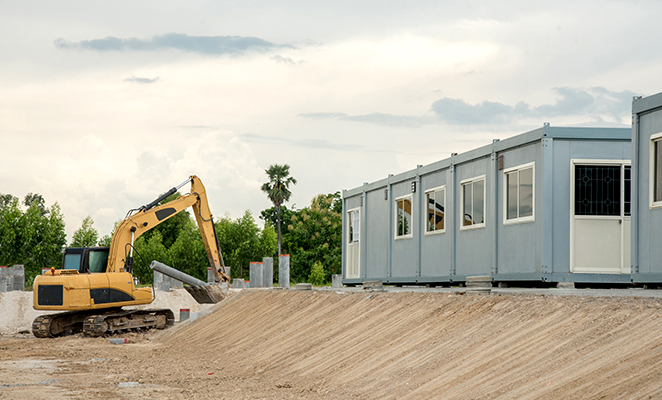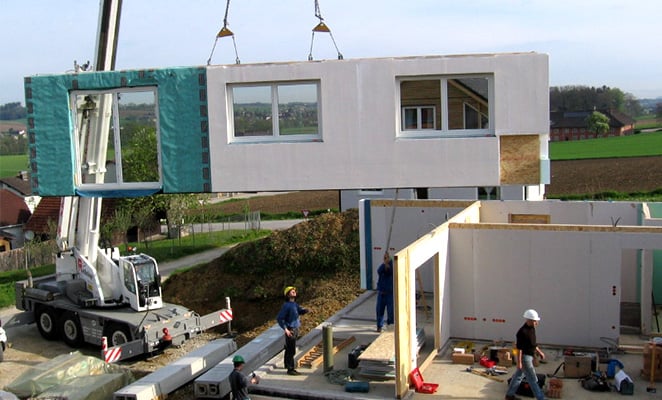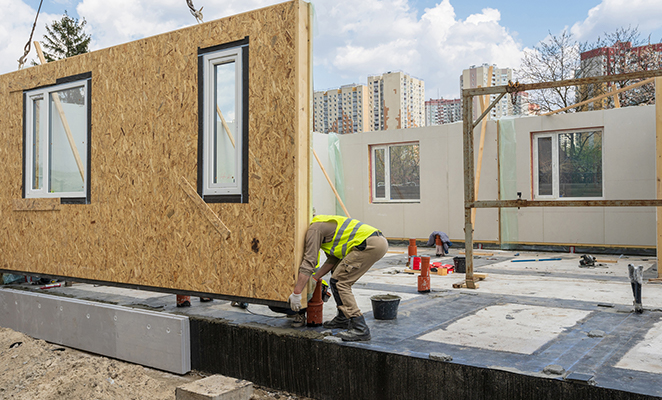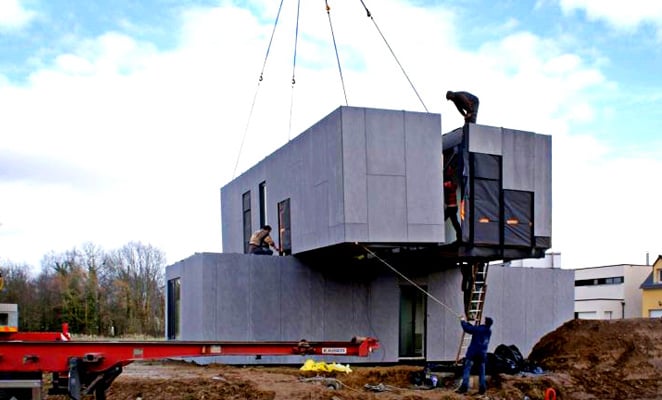Modular construction is a form of prefabricated construction (aka prefab construction), a building method that sources components that have been made offsite in a factory and then are transported to your jobsite to be assembled and form a structure.
Modular construction is an innovative and sustainable construction process that utilizes offsite, lean manufacturing techniques to prefabricate single or multi-story building solutions in deliverable module sections. These “modules” are later assembled onsite.
The modular construction process can simplify onsite building by limiting what needs to be constructed later on at the site of your build, and it can happen alongside design approvals and early site construction to considerably cut down the overall construction process timeline.
These “modules” are constructed in a controlled environment, inside a factory with stringent quality control processes in place to deliver components that are built exactly to spec.
Types of Modular Construction
There are two main types of modular construction:
Temporary buildings: Temporary modular buildings may be used to construct a temporary structure to be used for a certain period of time, but not to be a permanent structure:

-
Schools needing temporary classrooms during a building expansion
-
Construction site offices
-
Security offices at an event (music festival, large public gathering, etc.)
Permanent modular construction: These are permanent structures that use modular building components.

In this article, we’ll be focusing on the latter. Permanent modular construction may be used for a number of unique applications:
-
Private housing
-
Social/public housing, multi-family residences, etc.
-
Apartments and mixed-use buildings
-
Educational sector and student residences
-
Key worker accommodation and sheltered housing
-
Public sector buildings, like prisons and MoD buildings
-
Health sector buildings
-
Hotels and motels
Benefits of Modular Construction
So, what are the benefits of modular construction that would lead you to adopting this increasingly popular building method over traditional construction methods?
A mantra of modular construction might be: faster, greener, cheaper. Let’s unpack each of these a little more.
Faster Build Speed
With a traditional construction project, the build process is very linear, sometimes to a fault. You have to get all the necessary paperwork and permits approved and architectural plans greenlit before any work onsite can materialize. Then timely, labor-intensive site and foundation work needs to take place to ensure structural integrity. Then finally, building construction can proceed.

Modular construction offers a considerably faster build speed, a difference of as significant as 20-50% faster according to a recent McKinsey study. This is because, unlike traditional construction, as we discussed above, which necessitates a linear process, modular construction allows for structures and building components to be built alongside the foundational groundwork being laid onsite.
Modular construction makes sense when we consider that operational woes are industry-wide and missed deadlines are so common that as much as 29% of firms are putting longer completion times into their bids. New methods of building like modular construction offer a way to level-up your operations through strategic project scheduling. When combined with other innovative approaches like design-build methods, which seek to breathe new life into dated old ways of doing things and teach old dogs new tricks, no longer will you have to turn projects away simply because of scheduling conflicts.
Cost-Effective Option
In an industry that sees razor-thin profits while simultaneously being plagued by construction cost overruns that risk ballooning project budgets and financial stability, being vigilant with your building expenses is crucially important. The silver lining: According to the same McKinsey study, modular construction is a cost-effective option, saving more than 20%.
Environmentally Friendly
Another benefit of modular construction is that it has the potential of creating a relatively small environmental footprint.
In addition to being fabricated in a controlled indoor environment that allows for precision and little waste, modular building materials also use recycled materials. Furthermore, these components are made up of the most durable and eco-conscious materials, with internal walls sound-insulated and fire-proofed, making these components energy-efficient.
Finally, offsite construction—the assembly of the prefabricated modules on the jobsite—promotes less waste, allowing for a smooth and precise installation. If your company is serious about being sustainable, modular construction offers a way for you to make sustainability the through line of your project: source eco-friendly products, constructed in an eco-friendly environment, and assembled smartly.
Additional Benefits of Modular Construction
On top of these three main advantages, additional benefits of modular construction include:
-
Flexibility and customizable: Like LEGO® building blocks that allow children to explore endless creativity and construct virtually any structure, modular building components similarly can be built off each other into virtually any structure, while likewise meeting any space or budget constraints.
-
High quality construction: The controlled, indoor construction of modules guarantee quality and safety, preventing moisture and harsh weather of traditional build sites.
Modular Construction Disadvantages
With all this talk about how innovative and advantageous a modular approach to building is, you might naturally wonder if there are any tradeoffs. These are the main disadvantages of modular construction:
-
Transportation of materials: The delivery of modular building components to the jobsite may complicate matters. With the average module measuring 14 to 16 feet wide by 50 to 75 feet long, they may be too big to transport on your average road and will have to be craned into the site.
-
Land restrictions: Especially in the residential market, where town and city as well as homeowners’ association ordinances create a maze of approvals, modular builds may complicate your process and may even stipulate where you can build.
-
Financing difficulties: Especially in the residential market, modular builds complicate the process of getting a mortgage at banks unfamiliar with modular build processes who will need to a finance plan. To make matters worse, modular builds often require payments made up front, further setting off red flags with banks steeped in traditional mortgage thinking. On top of this, if you plan to sell your modular-built home, you might take a hit on resell value. That's because, in the residential market, modular buildings are typically associated with low-quality homes, despite modern structures and designs of modular builds being of the highest quality. It might take a while for the market to change their preconceived notions of modern modular builds.
Should You Adopt a Modular Construction Approach?
Modular construction is an innovative solution for a series of industry-wide problems:
-
Time: 66% of contractors carry added costs from overtime/second shifts due to schedule slippage.
-
Labor Shortages: 80% of contractors struggle to fill positions. That’s adding to the time problem, lengthening what you can get done with the team you employ.
-
Cost: Construction costs are rising in every facet of the process, from materials to wages to tariffs to rework.
Modular construction helps overcome these problems:
-
Prefabrication process happens alongside initial design and early foundation construction, delivering critical timesaving.
-
Simplified construction process limits who’s needed onsite to execute on design plans/assemble modules.
-
Cost-saving materials help keep project on budget and prevent cost overruns.
While there is a time and a place for every method of construction, and modular construction might not fit into every job, if it can be incorporated into your process, it’s worth a serious look. After all, 90% of firms using prefabrication reported improved productivity, improved quality, and schedule certainty compared to traditional stick-built construction, according to Dodge Data & Analytics. Those numbers don’t lie.





